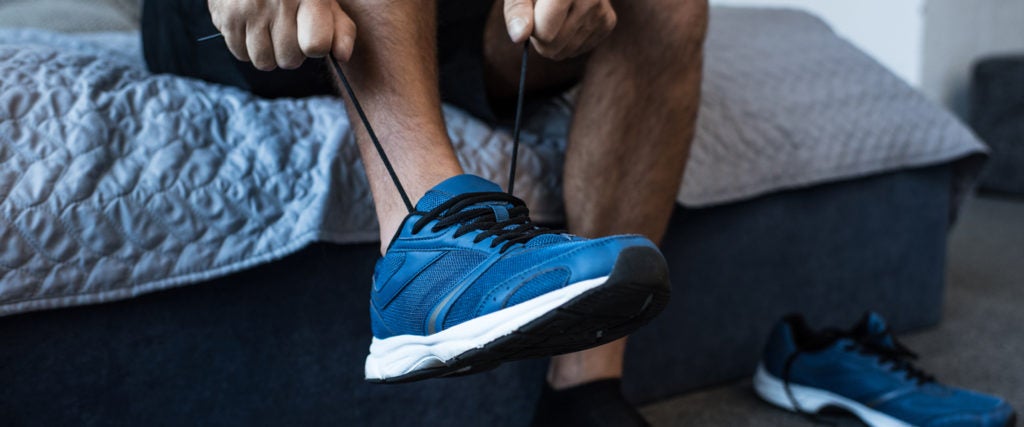There’s a shoe for literally everything these days. For proof, look no further than these clown shoes by Nike (which, since you’re wondering, are ostensibly for high-intensity interval training — like, jumping and stepping — and, full disclosure: my wife proudly owns a pair). But is this really necessary? Can’t you just wear whatever shoes you have as you work out at home during COVID? What the hell difference does it make? Do special shoes make working out somehow better? Or easier? Put simply: Do you need workout shoes at all?
Alongside Trevor Williams DPM, aka the Run Doctor, a podiatrist and foot and ankle surgeon who specializes in sports medicine, we’re tying on some answers!
Do you need workout shoes for different workouts, then? Or is it just to feel fancy?
“What I typically tell patients is, that probably would be dependent on your budget,” Williams says. “If you’re on a budget, you don’t have to go get a shoe for everything. You don’t have to have a shoe to row in, or lift weights in. You can get away with a couple of shoes to give you the advantages they each provide.”
Remember the cross-trainer? Bo Jackson’s footwear of choice? Williams says the problem with that shoe is that, unlike Bo, it didn’t actually do any one thing very well at all: They were lousy for running, lousy for basketball, tennis, racquetball, you name it.
So is it “better” to have a different shoe for different stuff?
Well, it can be. Let’s get something out of the way. Here’s what Williams says the data says for running shoes, which you can probably extrapolate to other activities: Running shoes do not alter your biomechanics. If you’re buying a specific shoe in order to run more efficiently, faster, experience less injury, “you’re going to be sadly disappointed,” he says. “That’d be like me going to the golf store and getting Tiger Woods’ clubs because they’re going to make me hit like Tiger Woods. That’s not gonna happen! The club doesn’t affect your swing; your swing is dependent on factors like strength, flexibility, muscle coordination — and running and exercise are no different.”
Williams himself doesn’t wear running shoes to do HIIT training. For things that require lateral movement, he finds that a simpler and more minimal shoe is more comfortable.
Comfort, huh?
Yes! This is important. “What the data will tell you is that the best characteristics for shoes overall are fit and comfort,” Williams says. “In other words, does it fit you? And if it fits you, that’s what you should use as your selection criteria.”
For example, sure, you could wear running shoes for your kickboxing class, as Williams has done. But he doesn’t find them very comfortable for that, so he wears something more appropriate. It’s more or less that simple!
Right, but what about injury? Is it harmful to wear the “wrong” shoe?
It’s hard to say definitively. Can shoes create injury? There’s just not enough data, Williams says. Studies have shown that you can alter the individual components of a shoe — the midsole thickness, the heel-toe drop, etc. — and it doesn’t change a person’s biomechanics. So what does? Strength, flexibility, alignment. Not the shoe.
“I don’t know of any evidence that would suggest that [wearing running shoes for, say, lifting weights] is detrimental,” Williams says. “People are free to use them. If it bothers them, that might be an indication — might be — that the shoe isn’t the right one for that activity. But it also could just as likely be your form for your activity is not right. So for weightlifting, maybe your form sucks and that’s why your foot hurts.”
However, you’ll tend to find that certain shoes will agree with you — and not agree with you — for a given activity. Go with your gut. But in general, if you can, use a shoe in the role for which it’s designed, Williams advises.
So what’s the right shoe for me?
Again, the one that fits and feels comfortable! Bearing in mind that actual science does go into shoe design, a chunk of the marketing is, well, BS. “There isn’t an evidence-based way for anybody to prescribe a shoe to you,” Williams says. “So I can’t look at your size — say you’re 6-foot, 180 pounds with a size 11 foot and you run this much — and say, ‘Therefore, this is the particular shoe you’ve got to get.’ It doesn’t work that way. Manufacturers will try to tell you that’s the case because it sells more shoes, but it’s not true.”
As a running-specific aside, there is some data suggesting that running shoes that are neutral versus motion-control shoes can be somewhat injury-protective, but Williams wouldn’t necessarily proscribe them as such because the evidence isn’t quite conclusive.
What about all the features shoes have?
Look, they’re often science based and interesting, but Williams says it’s hard for consumers to make sense of it all. Just try them all on. If a shoe works for you, great — that’s what it’s all about. Just ask yourself how well the shoe works for the particular activity. That’s evidence-based, he says, and will agree with the literature. It’s that simple, no matter what the shoe manufacturer or the salesperson tells you. And it’s the most important factor. “It’s an enigma that plagues people every time they go to a shoe store and look at a wall of shoes,” Williams says.
If the shoe fits and makes you want to put it on to exercise, then that’s the shoe for you — even if it does look a little insane.

